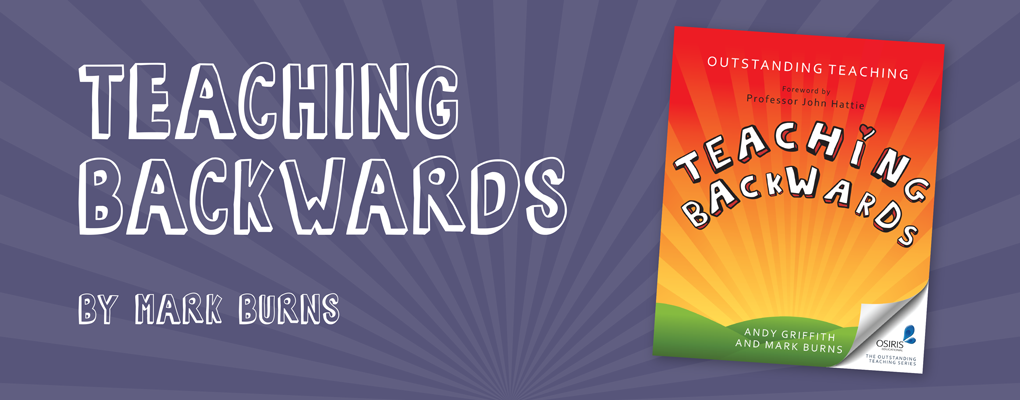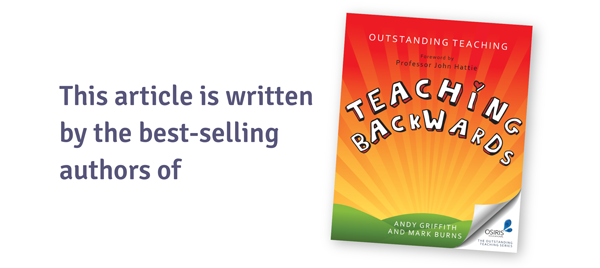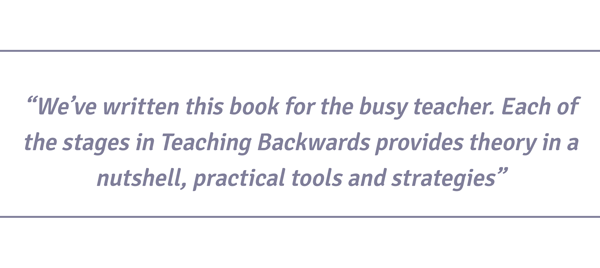Mark Burns is co-author of the book Teaching Backwards, the follow-up to the best-selling book ‘Engaging Learners’. Here we interview him about the book…
Why did you choose Teaching Backwards as the title?
The theme running through the book is thinking and planning with the end in mind . At the heart of Teaching Backwards is a thinking process that enables teachers to plan and teach backwards from a clear and well-defined destination.
For instance, this destination could be a model of a high-quality piece of work that shows learners exactly what standard they are expected to have achieved by the end of a learning module. But it also applies to the class or classes we are teaching.
Teachers who teach backwards are clear about the attitudes, skills and habits that they want their class to have, when they start teaching them. They then plan and develop their class to the point that they become the sort of class you’d love to inherit next September.
Where have this thinking and your ideas for the book come from?
As part of the Outstanding Teaching Intervention (OTI) programme, we have worked intensively with hundreds of teachers, in both primary and secondary schools, nationwide over the past ten years. Through this work we’ve had the opportunity to reflect on the key ingredients of the best 5–10% of these teachers. We’ve identified the common ingredients that make them so effective, day in, day out, as reflected by the progress their classes make and the high esteem in which they are held in their school communities.
Could you give us some of the key messages in the book?
Well, the first is that “assuming is guessingâ€.
Give us an example of what you mean by this?
Well, one particular lesson sticks in my mind. The teacher, Liz, had used all of the available data on her Year 7 class to plan her lesson. However, it became clear quite quickly that the lesson was pitched far too high for the class, and there was general confusion among the learners. Afterwards, Liz ruefully reflected that she’d just assumed, because all the pupils had at least level 5 on their SAT scores, that they would know how to do the basics. She then went on to critique some of her other lessons that had been unsuccessful in the past. The common cause was an over-reliance on data “to guessâ€, as she put it, the starting points of her learners. “I’m never going to guess again,†she said, with a determined gleam in her eyes.
For Liz, the transformational learning was that, if she was to fully embrace the practice of teaching backwards, then she would have to give more attention to discovering her learners’ real starting points. She realised that data alone could never give her sufficient information about her learners’ level of proficiency across the wide range of mathematical topics that she teaches them.
Why do some teachers make such assumptions?
There can be many different reasons. One is that schools are incredibly busy places. The number of interactions for a teacher even before the end of morning registration can be overwhelming for those not used to day-to-day life in a school. For many teachers, lunch is eaten on the go, or even at the end of the day sometimes. An unwelcome consequence of the speed of life in school is that it can infect the speed of a teacher’s thinking. When thinking speeds up, there is the danger that assumptions will be made. However, other teachers have reflected that they have not received enough training about the importance of pre-assessment.
So it’s just the assumptions about learners’ starting points?
No, far from it. The danger of over-assuming affects all aspects of teaching. From the assumption that learners are clear on what we mean by ‘high-quality work’ or ‘working hard’, to assumptions that can be made about whether learners have really made progress in learning. Indeed, in each chapter of the book we suggest ways to ensure that teachers do not fall into the trap of over-assuming.
How can this be overcome?
One of our book’s chapters is called ‘Looking for Proof of Learning’. In it we use a detective metaphor to describe a key aspect of what makes a great teacher. In our experience, the best teachers share similar qualities with the finest – real and fictional – detectives. Detectives, like our all-time favourite, Inspector Columbo of LAPD, develop excellent habits of noticing clues and gathering proof. We contrast him with another TV detective, Inspector Clouseau, who, let’s just say, is not so good. We suggest ways that teachers can imitate world-class detectives in their classrooms to enable them to more quickly address misconceptions and change the way they are teaching a topic or concept, if necessary.
When teachers become better detectives of learning, they are more thorough in seeking proof of how well learners are doing as they progress through each lesson, each topic, and over the whole academic year. Their success is based on planning which proof-discovering strategies they will use before the lesson starts. These may have to be adjusted based on the feedback that emerges, but they know that pre-planning and flexibility are the essence of teaching backwards.
What other key messages are in the book?
Well, Teaching Backwards is all about creating greater clarity. Our experience of working with black-belt (the best) teachers around the country has shown us that they use great strategies to support their learners to achieve clarity.
They use a variety of skilful techniques to de-mystify each learner’s destination, getting them to turn that into a personal goal, and then helping them to feel competent. The learners achieve this sense of competence because they see the value of the destination and feel confident that they can successfully manage the steps needed to get them there. Indeed, where learners have high levels of clarity, they are able to give themselves and their peers more accurate feedback.
So how might Teaching Backwards improve my teaching?
We’ve written this book for the busy teacher. Each of the stages in Teaching Backwards provides theory in a nutshell, practical tools and strategies, and the opportunity to consider which aspect of this stage could improve teaching and learning in their classroom. Every strategy has been road tested by teachers in primary and secondary schools. Many teachers who have taken part in our OTI programme have seen the quality of their teaching transformed when they have embraced the principles of teaching backwards.
Some have recognised the importance of building high expectations with their classes. Others have stopped guessing at the starting points of their learners. Still more have ceased to be vague about the destinations they want their pupils to reach and lax about how they will get proof of their learning. Instead, they’ve started to become more challenging, more disciplined in their planning, and more precise and skilful at getting feedback from their learners. They do less guessing and more investigating. They’ve got more empathy, but they accept fewer excuses.
Will Teaching Backwards just be a book?
No, we have also created a continuing professional development (CPD) course and INSET course based upon the book. SR
Outstanding Teaching: Teaching Backwards by Andy Griffith and Mark Burns
This book is the follow-up to the best-selling ‘Outstanding Teaching: Engaging Learners’. It is based on thousands of hours of primary and secondary lesson analysis, and forms part of Osiris Educational’s Outstanding Teaching Intervention programme.
In an increasingly fast-paced school environment, Teaching Backwards offers a more reflective and measured approach. Those who teach backwards start with the end in mind: they know in advance what they expect their learners to achieve, they define and demystify ambitious goals, and they establish their students’ starting points before they start to plan and teach. Teaching Backwards offers a practical, hands-on manual for teachers to further develop excellence in both themselves and their learners.




